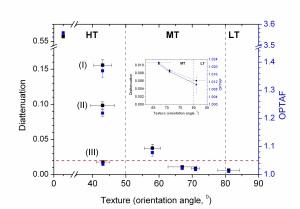The fuel of the High Temperature Reactor is made of a uranium kernel coated with three layers of pyrolytic carbon (PyC) and one of silicon carbide (SiC). Many times, SiC is regarded as the most important layer in the formation of this type of fuel, without considering the relevance of PyC. Most of the fission products are retained in the kernel and on the pyrolytic carbon coatings. Furthermore, PyC not only avoids the diffusion of elements that otherwise react with SiC and render it permeable but also it confers a higher stability to SiC due to a compressive stress introduced by the shrinkage of this material due to neutron irradiation. In other words without a stable PyC layer, the fuel particle would not be as effective in containing fission products as it is.
Among the different physical properties of PyC, its anisotropy has been probably the most studied. The term anisotropy is generally referred to the degree of orientation of the graphene planes. It should be mentioned that the value of anisotropy is not constant but depend on the microstructure and the sampling area. Unfortunately, this term has been used many times without considering that anisotropy might refer to different microstructural features depending of the scale length. For example, polycrystalline graphite is made of natural and synthetic graphite, each with a very anisotropic structure (where the graphene planes are well aligned). However, this material is made so the overall structure has a random or isotropic character. Due to the scale length this anisotropy can be described as macro-anisotropy and it is measured by techniques such as X-ray diffraction through the Bacon Anisotropy Factor (BAF). As the length scale is reduced between 0.2 and tens of micrometres, it is possible to measure the anisotropy of individual microstructural features, for example natural graphite (highly anisotropic) in polycrystalline graphite. These are the values obtained with polarised light (Optical Anisotropy Factor, OPTAF) and two modulator generalised ellipsometry (diattenuation and OPTAF), that can scan areas between 2 and 20 µm. For the case of PyC coatings, the values of anisotropy obtained will be affected by the shape of the growth features and the orientation of the graphene planes inside them. As the sampling area is reduced to 0.2 µm or lower it is possible to measure the anisotropy of the graphene planes with little or no effect of the microstructure. These values of anisotropy are obtained with transmission electron microscopy using the selected area electron diffraction patterns. This anisotropy can be referred as nano-anisotropy. Only in the cases where PyC is made of globular features with graphene planes oriented in a circular pattern, the micro- and nano-anisotropy will have similar values (Figure 1). Otherwise, the presence of polyhedral growth features or the orientation of the graphene planes parallel to the deposition plane will produce the deviation between micro- and nano-anisotropy (Figure 2).
Further information can be found here:
E. López-Honorato, C. Boshoven, P. J. Meadows, D. Manara, P. Guillermier, S. Juhe, P. Xiao, J. Somers. Characterisation of the anisotropy of pyrolytic carbon coatings and the graphite matrix in fuel compacts by two modulator generallised ellipsometry and selected area electron diffraction. Carbon 50, 680-688, 2012. http://dx.doi.org/10.1016/j.carbon.2011.09.027





